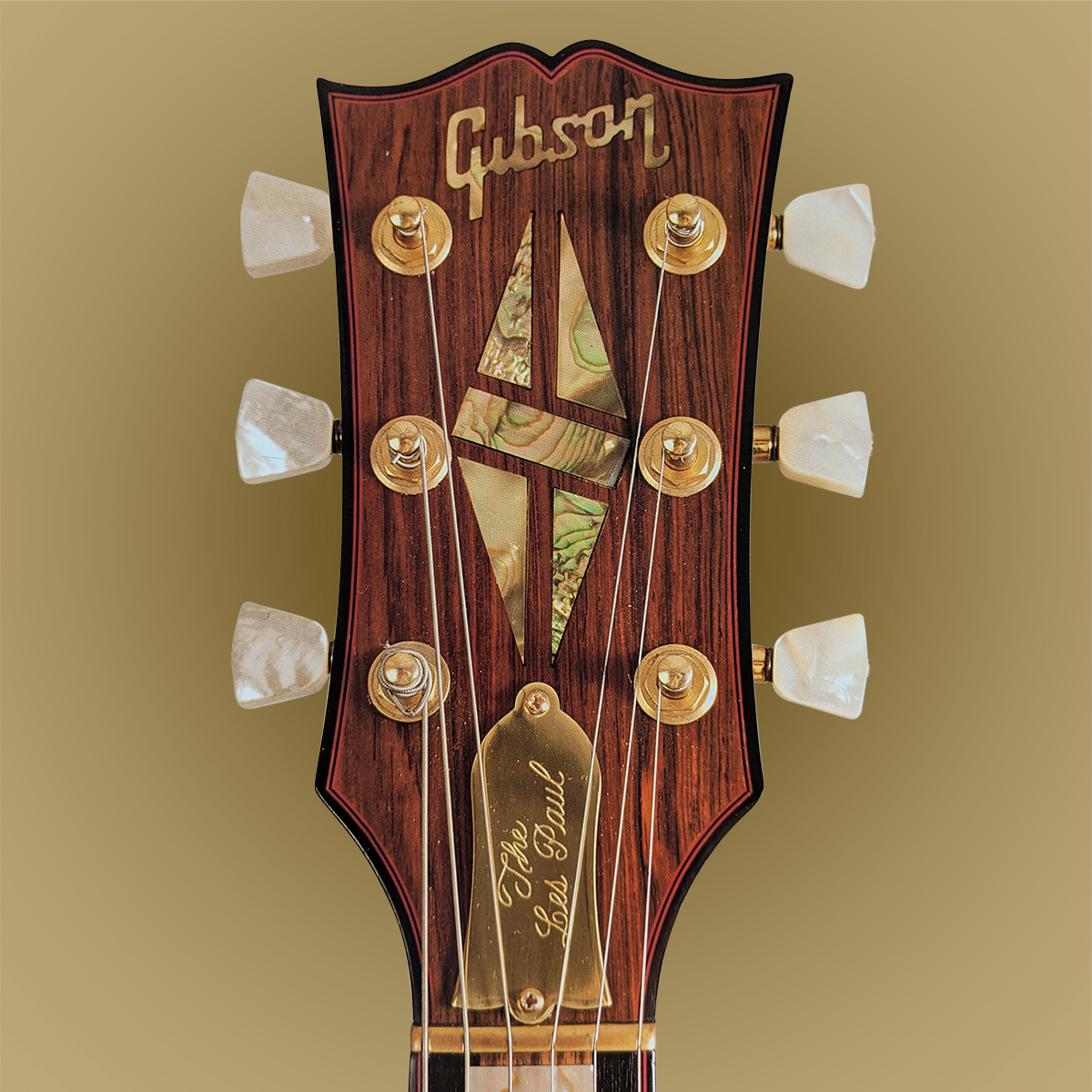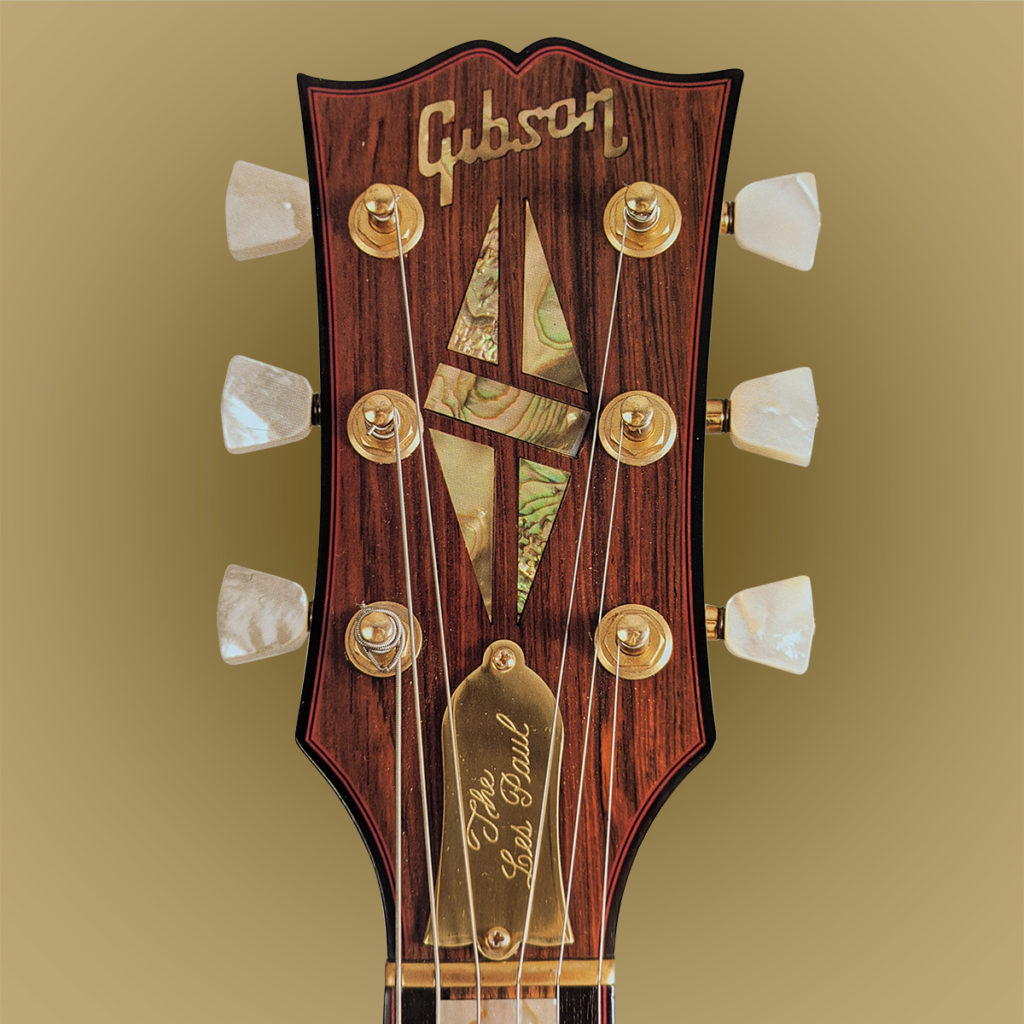
Walter Carter, 1994
A Look Back at a Living Legend
When you define music today, where do you start? The jazz and blues that led to the rock and roll rhythms which scored the 20th century? Or notes on a staff from the great classical composers of the 18th century? Do you dig deeper into the oral tradition of Gregorian chant and ancient history? Is it even possible to find accurately, or is music so innate and inextricable from life that it even predates the rhythmic beats of our hearts before birth?
Music is the legacy of this magical experience we call life; the shared harmony transcendent of language, race, and even species. For all of our amazing achievements of human life on Earth, the story of humanity is incomplete without music.
But if the song of human history were transcribed to sheet music, Gibson Guitars would be the crescendo. Masters of craftsmanship and unwavering pioneers of innovation, Gibson is a name so ubiquitous in the musical canon that a history of the form itself would be remiss without its own chapter. For that, we are excited today to take a nostalgic look back at the history of Gibson Guitars and a legacy of lutherie unrivaled in the industry.
Inspired by their ineffable contribution to music and craftsmanship, Calton Cases is proud to announce our kinship with Gibson Guitars. For each instrument they create, every angle, material, design, and shape is carefully considered to embody a musician’s spirit of artisan devotion. Music is an ecosystem; it is not just the music or the musicians alone, rather a network where every instrument created must be ferried in a quality case that protects it to a venue for a performance in front of fans that love to hear it. Any element missing in this journey obstructs the amazing, living organism that is music.
At Calton Cases, we love the instruments that make it possible for musicians to immortalize the legacy of their music and the world’s culture – a trait Gibson Guitars shares. It’s the reason we are so excited to champion Gibson Guitars today and further, to announce amazing news for future endeavors with this incredible company. But before we get too far in to the days ahead, let’s fortify this momentous occasion by a look at the past:
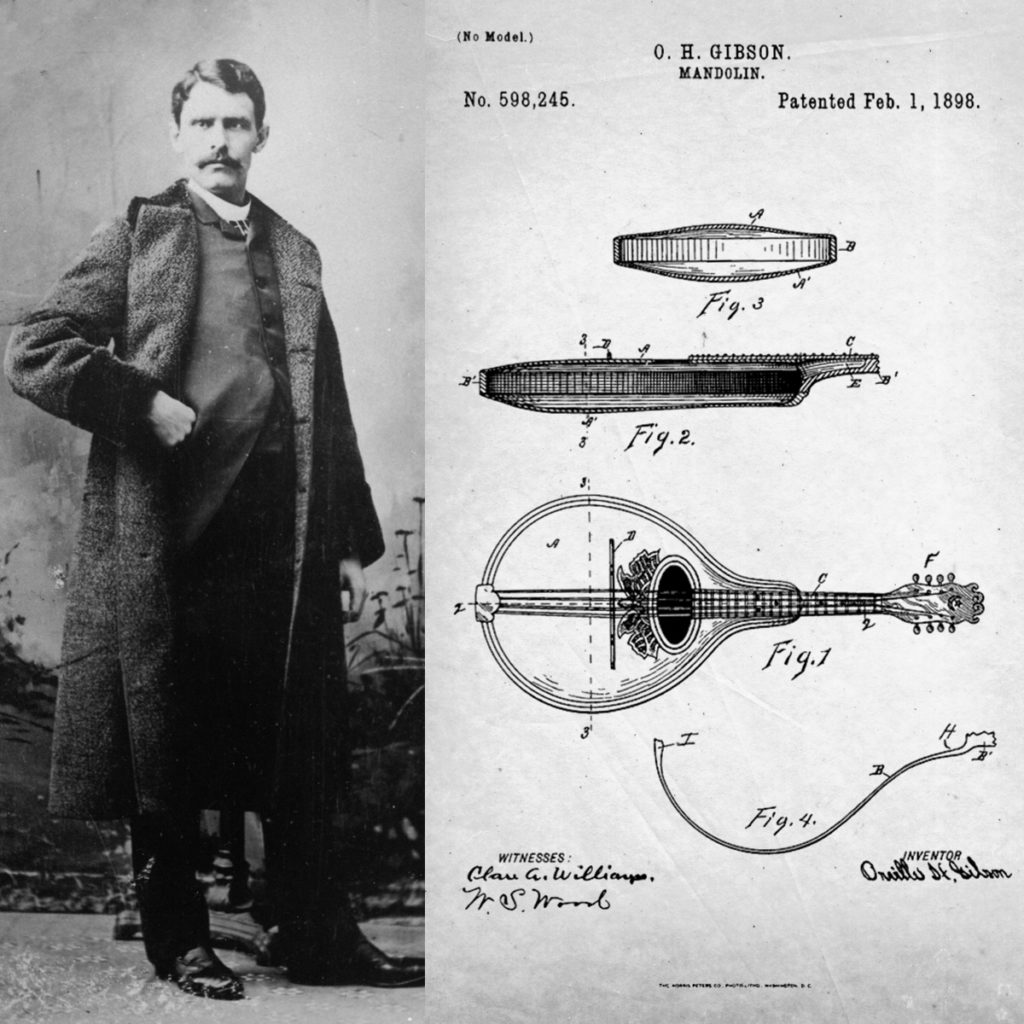
Chapter 1: Orville H. Gibson – The Legend Before The Epic
Gibson Mandolin-Guitar Mfg. Co., Ltd was first founded in 1902 by Orville H. Gibson and five forward-thinking entrepreneurs. But to really understand Gibson Guitars, you need to go back; back beyond its founding and even before the founder, Orville Gibson, to see ‘Gibson’ as more than a name; as a heritage.
Orville H. Gibson was born in Chateaugay, New York in 1856 to John and Amy Gibson.
Unlike famous instrument makers such as Antonio Stradivari (Of Stratavarious Fame) or even composers like Wolfgang A. Mozart, Orville did not come from a family trained or established in lutherie or even music at all. Orville, like his family, worked odd and essential jobs to get by. And, like his parents, he did not work as a musician or engineer. In fact, by the time Orville had moved to Kalamazoo, he was working fulltime as a shoe salesman.
But, like the musicians today who proudly play the instruments that bear his name, Orville Gibson was endowed with an insatiable drive to create.
As if compelled by some innate inspiration, Gibson embarked on a yet untapped trend in Americana, a brewing love of lutherie in the form of the mandolin. Moreover, Orville Gibson was not satisfied with the existing catalog of models and tones afforded to the 19th century selection of mandolins. Inexplicably, irresistibly, in spite of or because of everything that he was, Gibson could not quell the drive to create, and by May 11, 1896 Gibson had channeled his ceaseless drive for innovation into his first and only patent. With no background in carpentry or engineering, Orville took it upon himself to update an instrument already decades in the making. He realized that mandolins sounded better when carved from a single piece of wood rather than assembled from many separate parts.
Furthermore, he argued that although this method was more challenging, the resulting sound was worth the effort and craftsmanship necessary to produce mandolins in this style.
Gibson’s seemingly serendipitous creations soon proved their clairvoyance and became so revered by musicians of the era that the very same year his patent was filed, Orville was able to open his own shop in downtown Kalamazoo.
3 years later, he moved to a second floor shop on 104 East Main, located right in the center of town.
Orville enjoyed moderate success here and could have proudly boasted for this prominence alone, but as fate would have it, a group of industrious businessmen took interest in Gibson’s growing reputation and invested in Orville’s entrepreneurial spirit. The company they would help to forge in his name is a legend now over a century in the making; with centuries more to go.
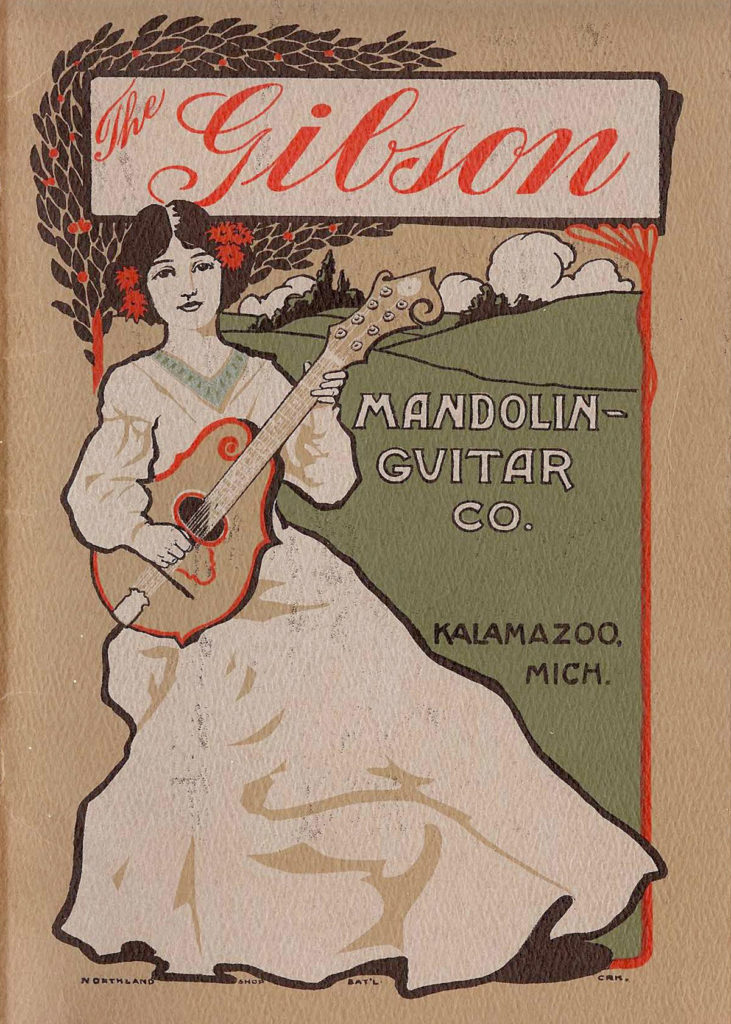
Chapter 2: The Origin of Gibson Guitars
On October 10, 1902 a formal agreement was reached between Orville Gibson and these 5 entrepreneurial businessmen of Kalamazoo. With backgrounds and pedigrees largely established in law, this group was an unlikely crew to become leaders in art and music. Odd mavericks for music that they were, this original Gibson sextet drafted a future for instruments and industry that would come to herald an essential music icon of our time. Like Orville’s own unique resume, this group would draw from some incredible and unseen source to create something truly legendary.
By 1908, Gibson was a household name, and Orville Gibson himself watched from early retirement as the giant that bore his name soon came to personify the growing American music industry. As the US was becoming recognized worldwide as a source for confidence, strength, and prominence, Gibson Mandolin-Guitar Mfg. Co., Ltd (later simplified to Gibson ltd) would score the spirit of American charisma and establish a brand that would rocket music culture and engineering into the stratosphere.
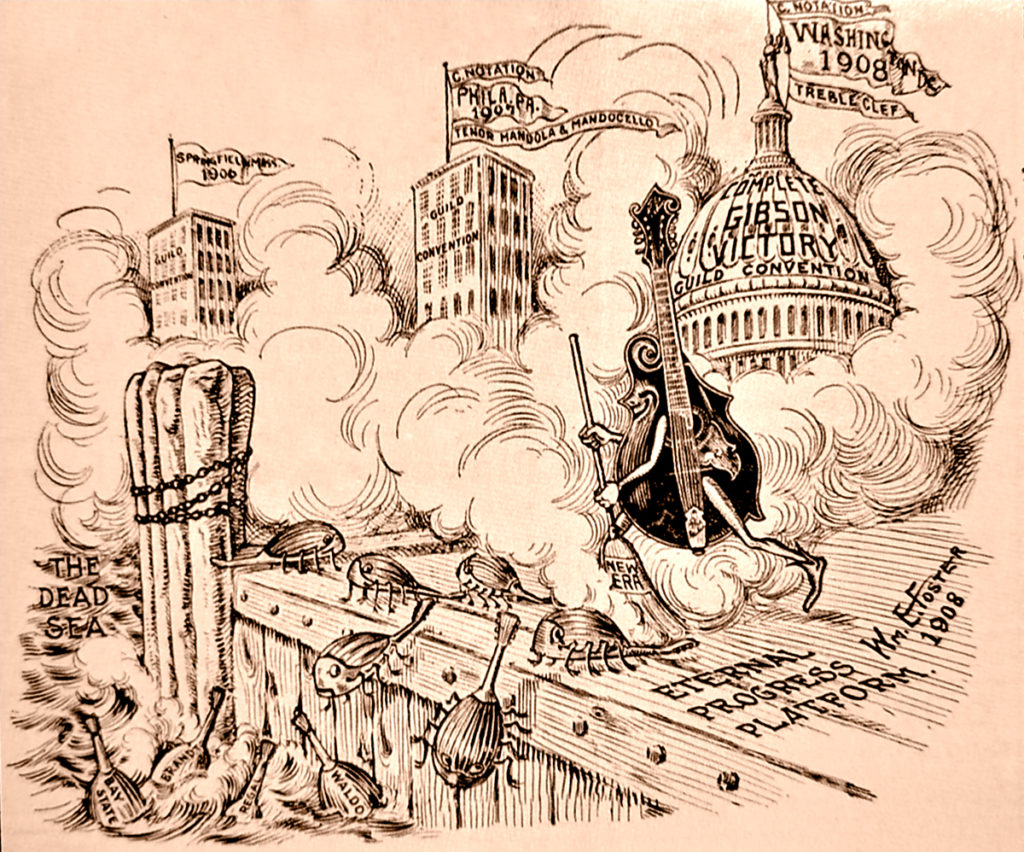
Chapter 3: The March to Prominence
Once armed with this legendary alliance, Gibson soared to rapid popularity; fast becoming the pinnacle of mandolin creation across the nation.
As if forged by the same Orville Gibson spirit, now emblazoned on their headstocks, Gibson Ltd continued to innovate and refine their instrument production over the years.
By 1908, their mandolin had evolved quite substantially from Orville’s original designs, creating instruments that consistently upheld a standard of quality while finding imaginative approaches to meet ever-increasing production demands.
Meanwhile, the mandolin quickly became the ideal American instrument and led to a rapid expansion of music and musicians. Was it a perfect storm? Did a sudden rise in music and recording technology lead to unprecedented success? Was it Gibson that drew new waves of people to music and to mandolins or was it simply a matter of being at the right place at the right time?
It’s unclear as to the exact degree Gibson altered and advanced the trajectory of music in America, but what is clear is that Gibson’s indelible mark on history is truly evident in this essential era of American innovation.
As masters of their craft, the picture of Gibson’s success is only half complete. For a full portrait of their prowess, one needs to consider the exceptional business acumen it took to create this indomitable company. Beyond the incredible leaps and bounds in production, Gibson’s sense of marketing and business ingenuity are a wonderfully unrivaled skill they demonstrate time and time again.
Through quality and directed advertising early on, Gibson offered a sincere welcome to musicians of any degree to advance their musicality on exceptional instruments. Meanwhile, through a program that partnered directly with mandolin teachers of the time, Gibson equipped educators with quality mandolins and the means to point their students to Gibson sales reps. This meant that people from an early age were afforded access to exceptional instruments on a massive scale.
For all of this, Gibson was powerfully poised to soar infinitely higher. But as fate would have it, new ulterior challenges were on the horizon and the team at Gibson Guitars would have to find new ways to innovate and excel in the wake of some of the hardest situations and pitfalls in this country’s history.
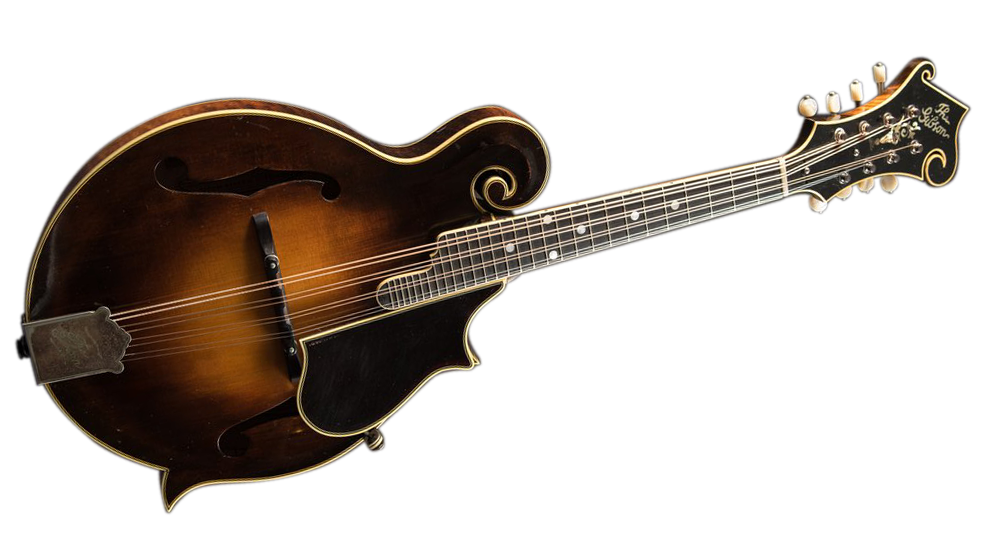
Chapter 4: Rising To The Occasion
Gibson Guitars, funny enough, never expected to be a leading manufacturer of guitars. In line with its original founder’s ideas and often on the pulse of America’s lutherie interests, Gibson invested heavily in cultivating a product line that met the demands of the day. For much of the early 1900’s, this meant catering to the generation’s taste for mandolins.
The pinnacle of this mastery comes in the form of Loyd Loar’s F5 series of mandolins. For many, these are often considered the stratavarious of mandolins, which to this day are still a truly unmatched instance of style, design, and sound. A set still prized by collectors the world over, (originals at auction have sold for up to a quarter of a million dollars) it was a fitting way to punctuate an incredible era of mandolin-making, all-the-while welcoming a new age of stringed instruments that would come to dominate the day.
But with the difficulties incumbent of World War 1 and later the depression, alongside the fabulous rise of Jazz, Gibson and their aspirations would soon be forced to evolve.
After the war, a search for identity led Gibson to working in unique avenues and to deepening their interests in instrumentation across the board. Banjos became the sound of the day and under the leadership of Guy Hart, Gibson explored Tenor Banjos as another avenue for creative expression. This signaled Gibson’s interest in exploring what it would mean to expand beyond the mandolin.
When the depression dominated attention in America, Gibson channeled their indomitable will and creative problem solving to remain afloat during one of America’s hardest times. In response to plummeting music sales, factories went so far as to produce a line of literal Gibson toys (think rocking horses instead of rock and roll) to supplement the strains of the music market.
Interestingly enough, the collapse of the stock market worked in tandem with the rise of another instrument that would come to define music for generations: the guitar. Gibson has basically had guitars available from its onset but the rise of Gibson’s dominance in this arena would coincide with the natural crescendo of America’s own musical persuasions.
In the years preceding the bounceback from The Depression, Gibson engineers released a profound series of archtops in the early ‘30s which eventually culminated in the beautiful Super 400. With a lower bout of 18” in width and fully dedicated to the finest quality materials and most elegant designs in the field, the Super 400 would serve as a powerful reminder to the world why Gibson is so often synonymous with luxury in the industry.
Meanwhile, the emerging power of electric instruments was fast becoming undeniable and soon Gibson would have to enter into the fray.
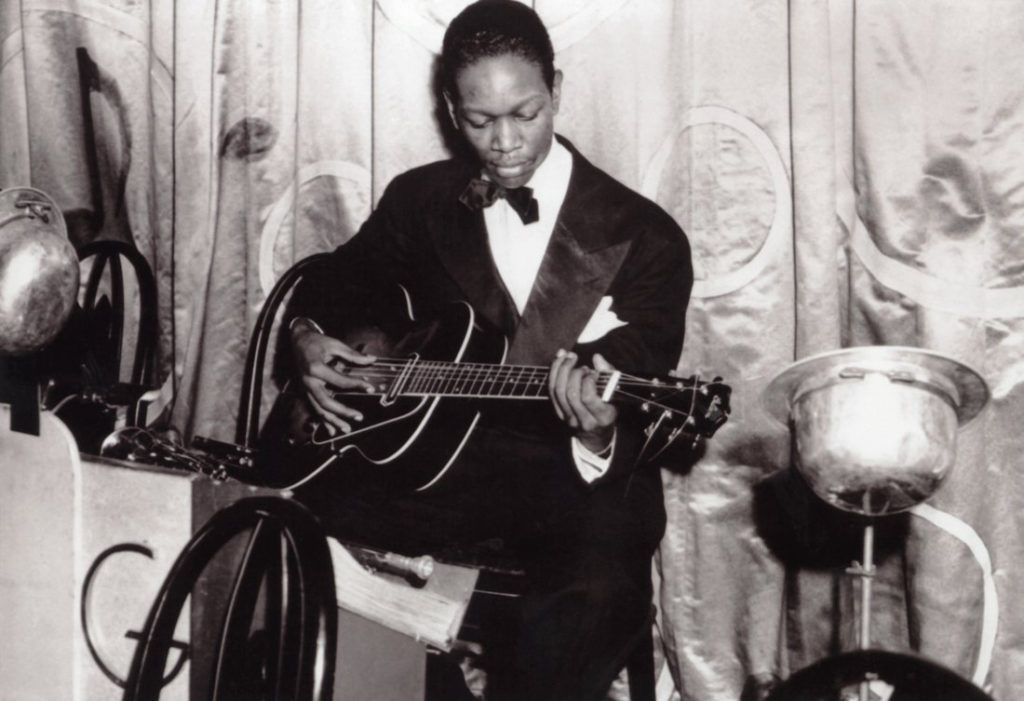
Chapter 5: The Charge of Electric Guitars
Like the debut of so many instruments before it, electric guitars made players nervous. It took advantageous trials and celebrations from talented musicians like Charlie Christian to showcase the amazing potential of this new instrument. Years before Les Paul, Christian rose to incredible acclaim with his breakout hit, “Solo Flight” on the exciting ES-150; an electric update that would finally afford players the volume and power needed to compete with the robust brass and big band sections which guitarists often struggled to shine alongside.
It is unfortunate that he would pass at the tender age of 26, but his exceptional legacy would live on as new players would take up the mantle of electric guitar composition.
For his and other’s contributions, the stage had been set for a musical revolution, but of course, fate would delay Gibson once again as the world would embark on its greatest conflict to date: World War II.
Musical ambitions were sidelined as Gibson joined in the war effort and focused the majority of factory operations on building resources for the allied initiative. It was a difficult yet essential time, but just on the horizon, Gibson’s best days were yet to come.
After the war ended, Gibson was in full swing and ready to show the world the power of electric guitars. At the time, many thought of electric guitars as a novelty, reserved primarily for the then popular hawain guitars (think more like ukuleles). Designs of the day were often lampooned and a new vision was needed to instill faith in electric guitars. For this, Gibson, with the help of enthusiastic endorsements from people like the aforementioned Charlie Christian, began to herald the sound and exciting prospects of the ES-150.
As blues and R&B overtook Jazz and Big Band, electric guitars fast became the hot new trend. Contemporary surges of enthusiasm sprung up in many ways across the board, but eventually, it was one man who, powered by the indelible design and engineering team at Gibson, was able to launch electric guitars into the stars. His name was Les Paul and his legacy in music is and forever will be etched into the headstock of any tale told of the greatest musical stylingings of the 20th century.
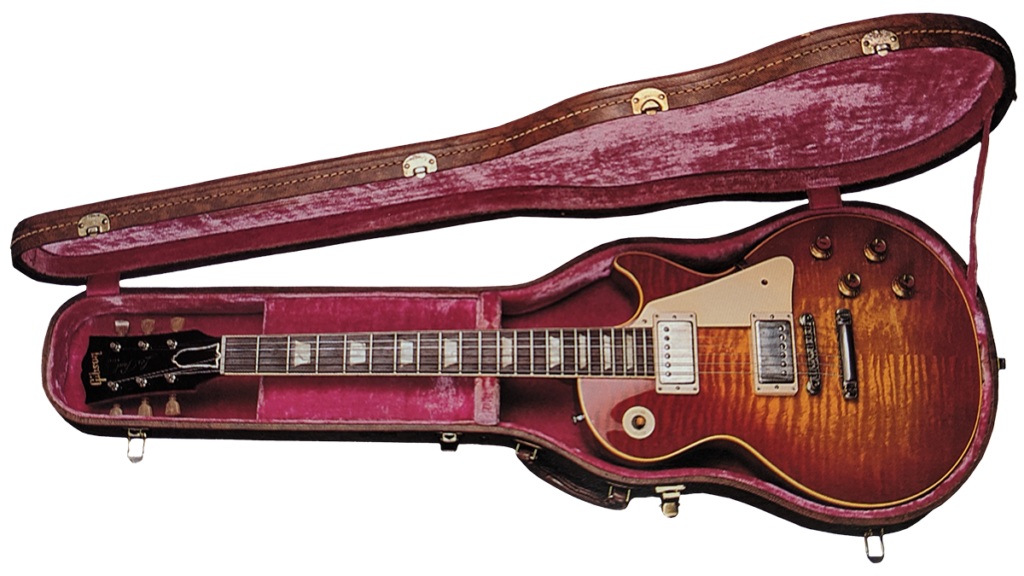
Walter Carter, 1994
Chapter 6: The Legacy of Les Paul
There is no guitar more famous today than the Gibson Les Paul. A historic piece of americana and an essential chapter in Rock ‘N Roll, the Les Paul was Gibson’s answer to Fender’s Telecaster and a triumphant masterpiece for music still resonating today.
Up to this point, Lester Polfuss had gone by many names. Long off the moniker “Red Hot Red” and well past his days touring alongside Pie Plant Pete as “Rhubarb Red”, Les Paul, as he came to be known, was a star fast on the rise through America’s new love of radio.
On par with his insatiable love for music, Les was enamored with exploring the promise of electric-powered music, and after a few notable creations of his own, was brought on to be the spokesperson for an incredible experiment.
When Gibson president, Ted McCarty dedicated a surprising amount of Gibson resources to a wild shakeup of the guitar industry at the time, the team delivered in the form of a solid body with a bold cutaway model composed of a mahogany/maple hybrid. This would prove to pay off for both Gibson and Les, and the results spoke for themselves:
In 1952 Gibson shipped 1,715 Les Pauls on its first year of release. The following year it shipped 2,245 (a greater number shipped than all of Gibson’s remaining catalog that year combined).
This amazing creation would continue to evolve through ensuing innovations like the 1954 Gibson ‘Tune-O-Matic’ bridge which enabled individual string adjustment. Additionally, through the humbucking twin-coil pickup, Gibson was able to corner what many today still champion as that distinctive ‘Les Paul sound,’ now an essential component to countless rock and blues records through the ages.
By the 60’s, electric guitars were a kingdom all their own, and Les Paul was king.

Chapter 7: The Electrifying Edge of Guitar Design
Gibson Guitars not only grew with the times, they lead the charge for innovation and eccentricity.
The explosion of pop and virtuosic rock music in the ‘60s prompted a decadent era of Gibson SGs that celebrated a legacy of excellence and elegance coupled with the prowess of modernity.
But as the Les Paul continued to dominate with a powerful reissue, Gibson discovered something else about electric guitars. The surprising malleability of solid body electrics meant designers suddenly found themselves free to explore the vast depths of opportunity for new guitar design.
These exotic characters of truly inspired creation came to personify much of the wild personality of rock and roll, eventually embodying a look and feel for the genre as inextricable to the age as the music itself.
And so began the hotly debated modernism movement. McCarty, as if powered by literal lightning, prompted a release of wild designs: The Flying V, The Explorer and even the now mythical Moderne.
These outrageous productions would test the sensibilities of even the most exotic rockstars and would come to embody the absolutely wild years of rock and roll the ‘80s is known for today.
Gibson remains an undisputed champion for musicians and instrumentation to this day. Their creativity and drive are apparent and infectious to all, and for these reasons, the future is as unpredictable as it is bright for Gibson Guitars.

The Next Chapter:
For all this, from the first mandolins, to the Les Paul, to the rereleases, from Orville Gibson to presidents who led through the years, Gibson Guitars’ namesake and claim to fame has always been a celebration of innovation, art, and exploration. Healthy competition and earnest passion for the craft has not only driven Gibson to incredible new heights, but has also raised the bar for craftsmanship and design from music to lutherie across the board.
Gibson is an American icon; a symbol for dedication to art and innovation unlike anywhere else in the world. This ceaseless march to perfection is how Gibson has remained the most influential guitar company in history. It is why Gibson Guitars has paved the way for another century of ineffable successes in guitar stylings and creativity.
It’s a quality we identify with at Calton Cases. It’s why we put so much care into our own cases. Guitars are not just a statement – they are a legacy, carried over generations in songs sung and stories told. Just like Gibson Guitars’ unmatched quality and attention to detail, every case here at Calton Cases is customized to every unique and amazing guitar that our shop sees on a daily basis. Every Gibson is a tool for legendary music in the making, and every Calton Case is an impermeable time capsule tailored to preserve it for a lifetime and more.
Undoubtedly, there is more to the narrative of Gibson Guitars, and we are excited for the future they have in store. It was only natural that one day we would find common cause, and for that, Calton Cases is thrilled to announce future collaborations with Gibson Guitars are in the works. More details are to come, so stay tuned for updates on this imminent collaboration between Calton Cases and Gibson Guitars.

